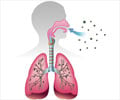A fungus that coats stored corn, wheat, nuts and rice in developing countries could be worsening the AIDS epidemic, a new study suggests

"Our work suggests study that aflatoxin exposure may be taking an even greater toll in areas where millions are infected with HIV, including Africa and Asia, the latter with a fast-growing HIV population and rice storage areas contaminated by fungi," said Pauline, Jolly, Ph.D., professor in the Department of Epidemiology within the School of Public Health at the University of Alabama at Birmingham (UAB). Strict regulation and monitoring minimize exposure in the United States.
Jolly and her colleagues recruited 314 HIV-positive people who were not yet on antiretroviral therapy for the study in Kumasi, Ghana. They divided patients into four groups based on their level of aflatoxin exposure and found that those in the highest exposure group were 2.6 times more likely to have a high HIV viral load than those in the lowest exposure group. Higher viral load translates into higher rates of HIV transmission and the potential for earlier progression to the opportunistic infections of AIDS.
"Previous studies by our team had looked at the possible interaction of aflatoxin and HIV on immune suppression, and this study examined twice as many patients as previous studies," said Jolly, the study's corresponding author. "It also was structured to eliminate factors such as opportunistic infections and antiviral combination therapy in clarifying the relationship between aflatoxin exposure and HIV for the first time."
Leading theories suggest that the fungal toxin may suppress the immune system by reducing the production of certain immune cells or the proteins that activate them. The toxin also may increase the expression of genes that result in more copies of the virus, but more study is needed to confirm the mechanisms.
Along with Jolly, the study authors were Seidu Inusah and Baogen Lu, M.D., in the UAB departments of Biostatistics and Epidemiology; William Ellis, Ph.D., Kwame Nkrumah University of Science and Technology in Kumasi; Alberta Nyarko, M.D., Kumasi South Regional Hospital in Kumasi; Timothy Phillips, Ph.D., Texas A & M University Department of Veterinary Integrative Biosciences; and Jonathan Williams, Ph.D., University of Georgia College of Agricultural and Environmental Science.
Advertisement
"We have done a series of studies now confirming a link between HIV viral load and aflatoxin exposure, but the problem has not yet been recognized or addressed," said Jolly, an HIV immunologist who does most of her work in Ghana. "While this study was larger than our previous study, a fungal contribution to HIV transmission will only be proved once and for all by larger randomized studies for which there now is no funding. The scientific and world-health communities need to decide soon whether or not this question is worth answering."
Advertisement
Known for its innovative and interdisciplinary approach to education at both the graduate and undergraduate levels, the University of Alabama at Birmingham is the state of Alabama's largest employer and an internationally renowned research university and academic health center; its professional schools and specialty patient-care programs are consistently ranked among the nation's top 50. Find more information at www.uab.edu and www.uabmedicine.org.
EDITOR'S NOTE: The University of Alabama at Birmingham (UAB) is a separate, independent institution from the University of Alabama, which is located in Tuscaloosa. Please use University of Alabama at Birmingham on first reference and UAB on all consecutive references.













